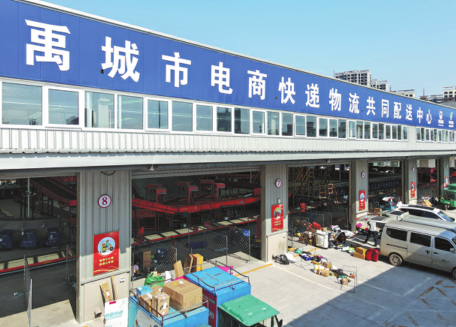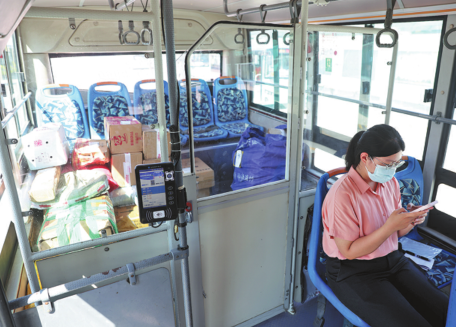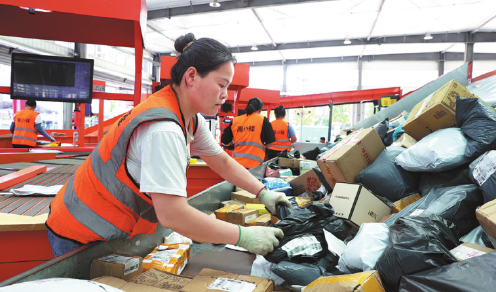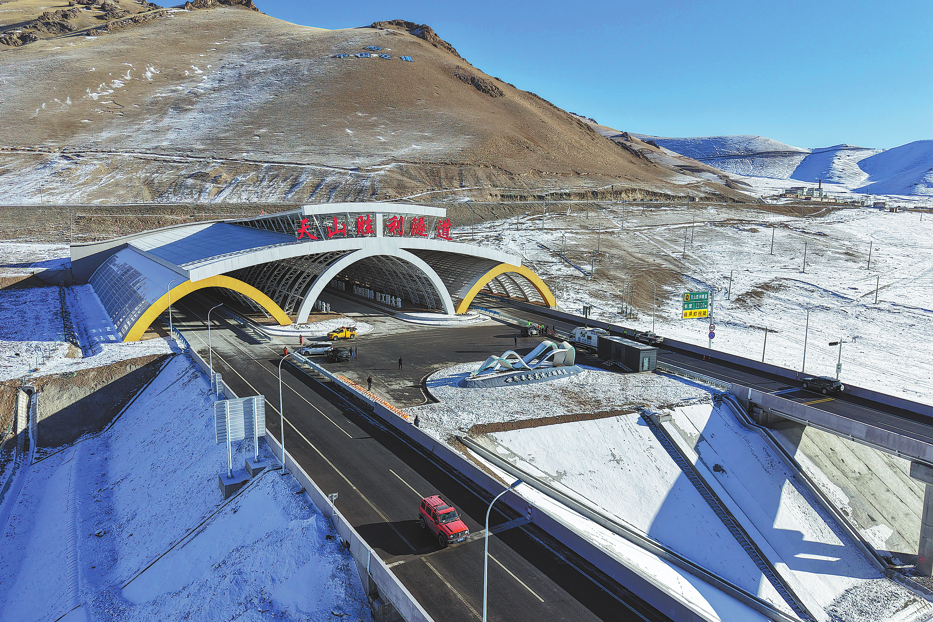INTEGRATED PARCEL SERVICES DELIVERING SATISFACTION
Transportation of cargo via scheduled buses is driving a breakthrough in rural areas

In Yucheng, a county in the eastern province of Shandong, it is common to see parcels and passengers sharing scheduled buses as they head to towns and villages in rural areas.
Transporting parcels this way is a new measure to solve "the last mile" problem and facilitate the delivery of parcels in rural areas.
It is also an example of the integration of the transportation of passengers, parcels and mail in the countryside.
All villages nationwide now have access to scheduled bus services that serve people's travel needs. However, some villagers still have to travel long distances to collect their parcels.
In Yucheng, though, parcels (aka "special passengers") can be carried on the bus to villages, and the new model has been shown to be efficient and successful.
The county has 45 scheduled buses on 28 routes that carry about 20,000 parcels to towns and villages every day, the Yucheng Transport Commission said.
At about 6 am, trucks carrying parcels from Jinan — which is both the provincial capital and the region's major parcel transfer hub — arrive at the e-commerce express delivery logistics joint distribution center in Yucheng. The center is located at the county's long-distance bus station.
Workers and a sorting machine quickly start working, busily unloading, sorting and reloading parcels. The items are then loaded onto buses to local villages, where they are usually left at a grocery store ready for collection by the residents.
"There is little demand for bus travel among people in rural areas nowadays. When the bus station was opened in 2010, there were about 3,000 to 5,000 passengers every day, but the number gradually declined to about 1,000 in 2016," said Bai Hongbin, deputy director of the Yucheng Transport Development Center.
"After the COVID-19 epidemic, fewer people traveled by bus in rural areas, so the service only has about 100 passengers now."
The station has a large waiting room and a spacious area for buses to park. Before, these areas were dedicated to the passengers' needs, but now, with few passengers or employees, they are empty most of the time.
As such, the waiting room is being renovated and is expected to be turned into a grocery store.
"People in rural areas have more choices for travel now, mostly driving their own cars and also taking trains," said Bai to explain the decline in the number of long-distance passengers.
He added that the operation of buses in rural areas faces great challenges, so the integrated use of transportation of passengers and parcels by bus is a win-win situation.
Joint distribution
The joint distribution center was established at the bus station in September last year to accommodate parcels from five major delivery companies: ZTO; YTO; STO; Yunda; and J&T Express.
"Our center receives about 70,000 parcels every day, and it delivers to 544 villages across the county," said Ren Jianbin, who is in charge of the center.
Trucks arrive twice a day, in the morning and the afternoon. It takes about 2 1/2 hours to sort the packages in the morning and afternoon, respectively, he said, adding that since the center opened, more parcels have arrived every day. Villagers are now more likely to use e-commerce services and place orders online, Ren said.
Before the center was established, about 50,000 parcels arrived at Yucheng every day, he said, adding that the number is expected to grow next year. The introduction of a sorting machine at the center has cut the time required for unloading, sorting and reloading. In the past, sorting was completely dependent on human labor, which took up to seven or eight hours a day, he said.
Before, most parcels would be delivered to rural areas the day after they arrived from Jinan, but now all those that arrive at Yucheng can be delivered to villages via scheduled buses within 24 hours. No parcel stays overnight, according to Ren.
"It has improved efficiency and reduced the time for parcel deliveries. Our intention is to benefit local people, bring effective express delivery services to villages and also control operating costs," he said.
Another innovation has been the accommodation of the five parcel delivery companies at the distribution center to solve the "last mile" problem.
Companies send their parcels from Jinan to Yucheng via their own trucks. Once the parcels arrive, the center's staff members handle the rest of the process — receipt (including sorting), reloading, and delivery to customers — no matter which company the parcels belong to.
It is costly for the companies to make their own deliveries to rural areas as the number of parcels they each deliver to individual villages is comparatively low, said Bai from the Yucheng Transport Development Center.
"It used to be a vicious circle. Because many parcels could not be delivered to villages, local residents were reluctant to buy things online. Thus, parcel delivery companies received less business in rural areas, which made them reluctant to spend more to deliver in those areas," he said.
To solve the problem and better integrate resources, the center was founded under the guidance of the local transport commission.
Since then, parcels from all five companies have been sorted and delivered together, reducing costs and improving efficiency, Bai said.
Ren, from the distribution center, said that cooperation to facilitate joint deliveries was not easy at the start. "Companies fought for the distribution of profits," he noted.
Ensuring safety
After the parcels have been sorted, they are loaded onto scheduled buses to begin their journey to the customers.
To ensure safe transit, buses that carry both passengers and parcels have been modified. The seats in the rear half of the vehicle have been removed and a transparent partition has been installed to separate passengers from the parcels. The passengers take the front half of the bus, while the parcels take the rear.
"Most express parcels are not heavy as they are mostly small items. However, for safety reasons, we have installed partitions to separate them from the passengers to ensure that the parcels and the riders won't collide in the event of sudden braking," Ren said.
When a route 61 bus stopped at the distribution center at Anren town on Aug 30, workers immediately unloaded the parcels.
Many villagers quickly lined up at the center to collect their parcels. Lu Hengyi, a recent high school graduate, had bought some school supplies and snacks in preparation for college, so he picked up a number of parcels at the center on Aug 30.
"I usually come to pick up several packages each time," he said, adding that it is convenient to collect the parcels from the center.
"It takes about five to six minutes to travel from my home (by electric bike) to the center to pick up parcels. It is quicker than before."
Collection convenience
Some young children and elderly people were also collecting parcels at the center.
"Before, the villagers didn't usually write their address in detail. They just wrote the name of the local township (because parcels were only sent to towns) and picked up their parcels there. Now, many villagers write their home address because parcels can be delivered to villages, which are closer to their homes," said Liu Yu, director of the Yucheng Transport Commission's postal development center.
In a grocery store in Qiyao, a village in Yucheng's Anren town, many parcels from different parts of the country were stacked up, including mooncakes from South China, snacks and many daily commodities.
On Aug 30, local villagers stopped by, picked up their parcels from the shelf and scanned a code at the counter. Many of them were seniors, but some were children.
"Before, the villagers had to travel to the town to pick up their parcels, but now they come to my store to collect them. More people are visiting my store and I have a higher income," said Pang Xiaolian, who owns the store.
About 20 to 30 parcels arrive at Pang's store every day, but during peak periods, the number can reach about 100.
Li Jun's grocery store in Yucheng's Nansun village has become more popular since June, when the buses that carry parcels began stopping in the village.
"Many local people come to pick up their parcels at my store," the 66-year-old said.
At about 10 am, Li receives parcels from the scheduled bus. He registers them and stacks them, which makes it easier for villagers to collect their goods.
"In the past, villagers had to travel at least 30 minutes to pick up their parcels in the town. Now, they just walk to my grocery store and collect them," Li said, adding that about 100 to 200 parcels are delivered to his premises every day.
Agricultural produce
The improvement of the rural logistics system has not only boosted the movement of manufactured goods from the urban to rural areas, but also facilitated the transit of agricultural produce in the opposite direction.
In Qiyao, many villagers make a living by growing pears. "Now, people can easily send their pears to customers in other parts of the country (via the rural parcel delivery network)," said Liu Xiangzhu, the village head.
Ren Fengying, who owns a pear orchard in the village, has been growing the fruit for more than 30 years. She never used to worry about selling her crop.
"When the harvest season approached, usually in September, many customers drove to my orchard to buy pears. My pears are of good quality and very sweet, with thin skins," she said.
However, she faced a big challenge in September last year as the COVID-19 epidemic meant that fewer customers traveled to her orchard to buy fruit.
However, assisted by the local rural vitalization center, her pears sold out in a week via a livestream on a short-video platform and were sent out via the local parcel delivery network.
Nationwide promotion
The practice of carrying parcels on passenger buses to facilitate delivery in rural areas is not just being developed and promoted in Yucheng, but also encouraged in many other parts of the country.
In recent years, the State Post Bureau of China has guided various regions in promoting the parcel delivery service to rural areas by taking advantage of scheduled bus services. It encourages the sharing of facilities and the use of rural passenger transportation vehicles to deliver mail and express parcels, while also ensuring safety.
In June, the bureau, the Ministry of Transport and other government departments held a national teleconference to promote the integrated development of bus and parcel delivery services in rural areas.
The parcel delivery sector has boomed in China over the past decade, with more than 110 billion items handled last year. In 2012, the number was 5.6 billion. The growing popularity has also been seen in rural areas, where about one-third of parcels nationwide were delivered and collected last year. That has provided great support for the rural vitalization initiative.
Now about 100 million parcels are delivered and collected in China's rural areas every day.





Today's Top News
- China's finance minister pledges expanding fiscal spending in 2026
- CPC leadership meeting urges steadfast implementation of eight-point decision on improving conduct
- Autumn grain purchases exceed 200m tons in China
- Wang to meet foreign ministers of Cambodia, Thailand in Yunnan
- China's top legislature concludes standing committee session
- Thailand and Cambodia agree to temporary ceasefire






























